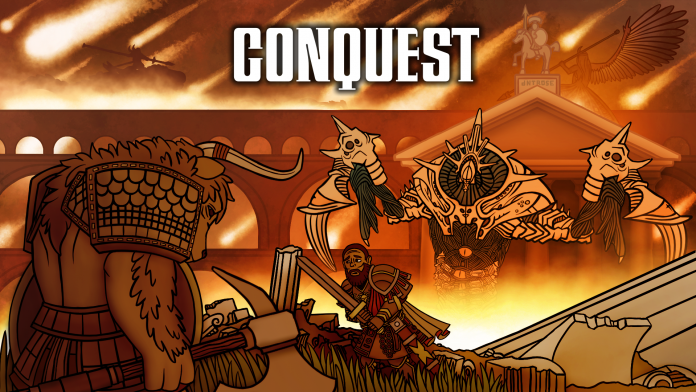Welcome good gentles all to the official Goonhammer Conquest Mid-Year Tier List! We reckon this is a good time to take a quick stock check of where Para Bellum’s Conquest: The Last Argument Of Kings is sitting right now, with a number of major events (Cancon, Adepticon, LVO) down, and Worlds fast approaching in September. Conquest has a reputation for being a pretty tight ruleset with a development team paying close attention to the meta, but do we agree? How does Goonhammer’s panel of Highly Trained Experts™ feel the balance is in a game that’s both so new and growing so fast? Let’s find out.
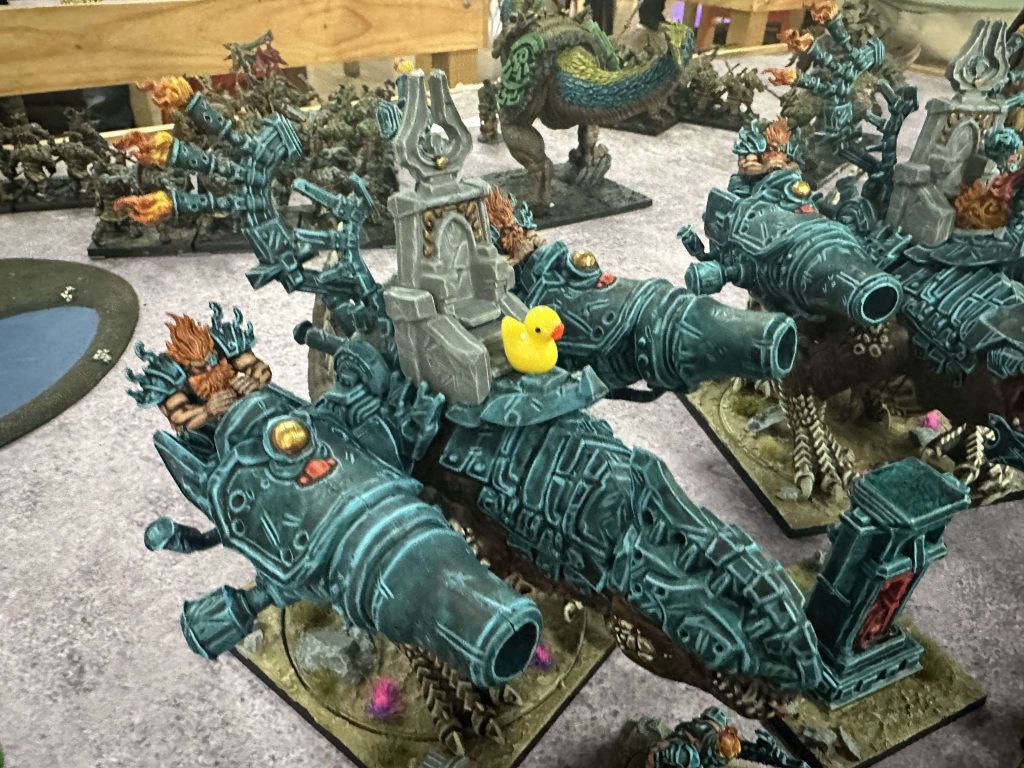
We want to be absolutely clear here: this article is almost entirely based on vibes and personal experience. Conquest does not have the number of games played or data collecting methodologies which allow analysis like the wonderful Competitive Innovations series we have for Warhammer 40,000, for example. The community that Sockbert, Thanquol and Rob Shepherd all call home had its world rocked when the tontorr dropped and Sockbert bought the first of what would eventually become three giant dinosaurs; one person buying one model completely skewed the data. That said, tier lists are also Cool And Fun, so let’s dive in.
How This All Works
Here in the Goonhammer offices we have Conquest reporters on three different continents, and we’ve asked them to rate each faction on the traditional SABCD tier list spectrum. Here’s how we’ve broken it down:
S tier – A problem army. This faction is overly powerful, and needs to be toned down, likely for both game balance and avoiding negative player experiences. If you really want to win an event, start looking here.
A tier – Above the curve. Maybe they have a few exceptionally strong pieces or builds, or maybe they’re just a bit stronger than average across the board. A few targeted nerfs might be in order.
B tier – Perfectly balanced, as all things should be. This faction is the middle of the pack; neither particularly powerful nor weak. They may need to play a certain way to succeed, but in the right hands they’re absolutely able to place at events.
C tier – A little weaker than average, but still entirely playable when led by a skilled general. A few tweaks would push this faction up into doing much better. Unlikely to win events.
D tier – This faction needs a complete rework. Even with exceptional leadership they may struggle to win more than they lose; a priority for a balance patch.
We’re taking this as a point in time assessment, only considering models and units that have been released; as excited as Sockbert is for the Quatl, they’ll have to wait a while longer to see how that changes the W’adrhŭn. We’ve also made sure that each contributor has only rated the faction they have experience playing with or against, meaning that our Sorcerer Kings rating is a little lower confidence than the rest of our glorious armies.
Let’s dive in.
D Tier
There are no D Tier factions right now! A sign of good balancing.
C Tier
A new player who selects their first Conquest army today has a nearly fifty-fifty chance of selecting something that’s just slightly below average, with three out of eight armies sitting in the C tier. This might seem like a bit of a problem, judging almost half the armies as needing a bit of a bump, but very much on the positive side Para Bellum stubbornly refuses to let any army slide to D. In fact, with our six contributors making 46 votes between them, only a single cynical soul rated any army as D. Honestly, that’s alright.
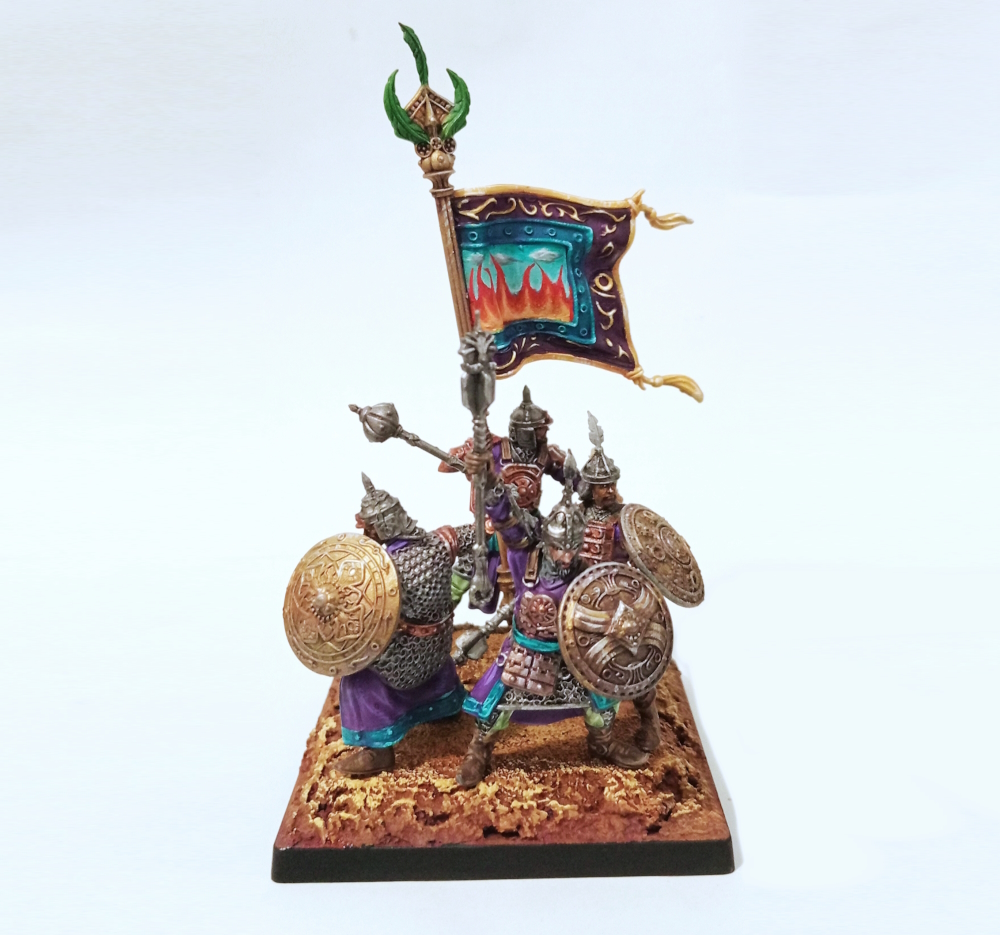
Sorcerer Kings – C
Starting at the bottom, Sorcerer Kings roll into the bottom slot purely because they’re the game’s newest faction and, at time of writing, still have a lengthy release schedule ahead of them and with their balance yet to be fully dialed in. There’s a lot of chewy synergy and a fairly high skill cap to explore with this faction, and there’s a strong chance they’ll overtake Nords as players come to grips with them and really demonstrate what they’re capable of. However, at time of writing, they’re unproven and still working through their growing pains. Their early releases have covered a lot of bases (multiple courts, a good mix of light, medium and heavy regiments, all the characters, etc) but the faction is still at the stage where every release is potentially transformational (Dhanur disciples and the Mahut are both on the horizon, for example) and Para Bellum also made some early changes to the Ritual mechanic to help with administrative overhead that has had balance repercussions that may take some time for future updates to resolve.
General Cross: Sorcerer Kings have had a bit of a shaky start in life. Much like W’adrhŭn, they are a complicated army that are easy to make mistakes with, and don’t have the durability to forgive those mistakes either. Some quality of life changes have helped, and seeing more of their core units such as Dhanur Disciples and the Mahut will open up the faction more. Unlike City States, they lack that early release power build that can top big events though, so it will take time and lots of player experience to see what this faction is capable of.
Rob: The first year of a faction’s release has historically been a bit of a rocky experience as you ride the rapids of releases and rules updates, and Sorcerer Kings are having a rough time of it. Shortly after release, the ritual mechanic underwent a major change to reduce the amount of administration the mechanic required down from dozens of discrete actions every turn to a clearer and more manageable number. This was an improvement for approachability, but the change moved the progression of ritual timekeeping from unit activations to character activations.
In a vacuum, this helped reduce the management overhead, but the faction’s entire internal design cycle seems to have assumed armies would be built with a large number of regiments around a small number of powerful characters (which you can see in the faction fluff, and the rule allowing them larger than usual regiment counts in warbands), which has been completely upended by the change. Sorcerer Kings simply aren’t designed to accommodate the average of three or four characters they currently need to progress rituals, and the rebalanced rituals themselves mostly boil down to having as many copies of Conflagration running as you can at any given time (although there are a few other niche but solid selections, like Intrusive Thoughts, or Sayf on powerful ranged units).
However, I’m absolutely confident these are challenges that the design team is aware of and working on. This makes Sorcerer Kings a faction to watch – even with their challenges, internal elemental synergies give them a mix of speed, scoring and the ability to build up and surge into action multiple times as a game progresses, which is an extremely promising archetype and it’s a credit to those mechanics that Sorcerer Kings are still hitting a comfortable C-tier and not any lower.
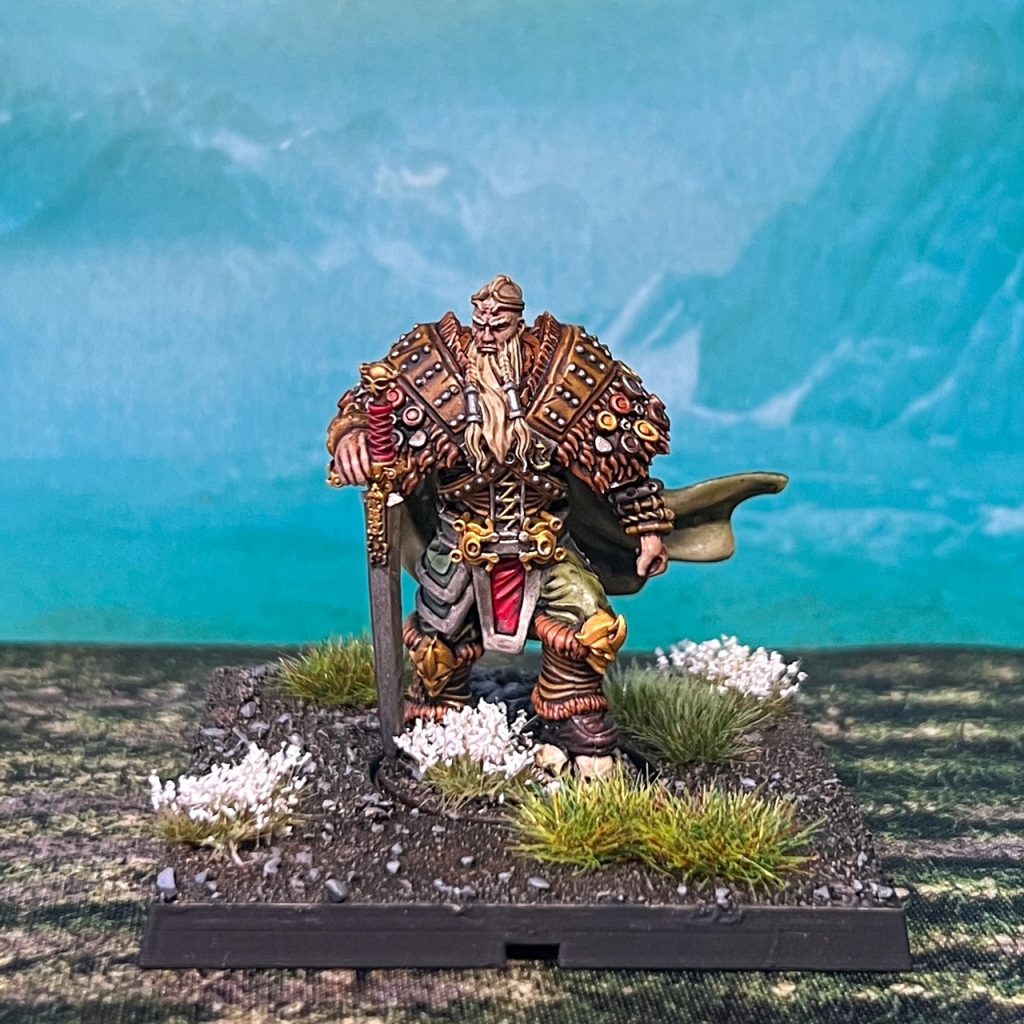
Nords – C
Just slightly above the elemental masters lie the Nords. But wait, we hear you cry, your plaintive wailing reaching the very heights of our ivory tower: Nords won Adepticon! Nords are in a great spot! To which we answer, nay, dear heart. Nords didn’t win Adepticon; Chuck Elswick won Adepticon, just as he’s won many, many other events in Warmachine and Hordes. Nords themselves are currently in the midst of an identity crisis, where beefy muscular lads and monsters look like they want to slam headfirst into their foes like the orcs of other games; maybe a bit hard to control, but a solid footy headbutt in a world of ballet dancers. Instead, they’re almost a surgical instrument, fragile as hell and dealing obnoxious damage when their general can wrangle them together. This dichotomy means that most generals are going to play them against the design intent of the army, with an ugly result. Remember that one single vote for a faction to be placed in the “D” tier? That was Sockbert, and it was because Nords need more skill than average just to be, well, average.
Sockbert: My personal loathing of all things Viking aside, the army is just too fragile in a meta dominated by the resilience of Old Dominion and Dweghom; those armies can take the Nords’ first hit, then do unspeakable things to them on the backswing. Nords have the same design problem as W’adrhŭn except at a much harsher level; there’s absolutely no safety net here if you play the army “wrong,” no simple bucket of stats to rely on if you trip up. We’ve had multiple locals dive into Conquest and pick up the Cool Viking Dudes, only to give up the entire game once they found their mental (and physical, with the models) image of the faction did not match the game designer’s intent whatsoever. Nords need a redesign, stat.
General Cross: Once we remove Adepticon 2024 as an outlier, it’s clear to see that Nords are not consistently outperforming other factions. I also think it proves that you can compete with every faction at a high level, which is an excellent reflection on game balance. They’re an unforgiving army to play with low Defence and Resolve generally. I’d personally like to see Nords slowed down a bit in exchange for higher damage; making them serious threats if not completely put down.
Sam Isaacson: Nords are meant to reward the aggressive player. Racing across the table before opponents can get themselves set up, berserkers screaming with bloodlust from every direction, their idea is to cause just enough chaos to make the first half of the game extremely annoying for their opponents while they take a lead and the sturdier, slower units get into position. But they’re not overpowered enough for that approach to work in most cases. Their early units die too quickly without doing enough damage, making most games feel like a foregone conclusion.
Rob: I can’t help but wonder if some of the issue with Nords is that they’re designed to play a lot like Wood Elves, but even their treekin-analogs like Ugr and Jotnar are also high-damage and not notably durable (rather than being the kind of storm-weathering anvils the faction would potentially benefit from). It’s always a dangerous ask to say that every faction should regress toward the mean – outliers are what makes the game interesting! – but with only a few exceptions, Nords feel like they’re all forward gears that can just grind out if they hit a faction that endures them, out-activate or out-threatens them, or just trades comfortably.
B Tier
There’s an argument among tier list aficionados sometimes that in a perfect game, all armies would be in B. Whether this is true or not is lively debated in our offices, but with only two armies here it seems like Para Bellum doesn’t really agree with that claim either.
(Rob: You’ve activated my ‘balance is a subordinate design goal to fun’ trap card. In this essay I will- sorry, sorry. Tier list. I’ll rant about this elsewhere.)
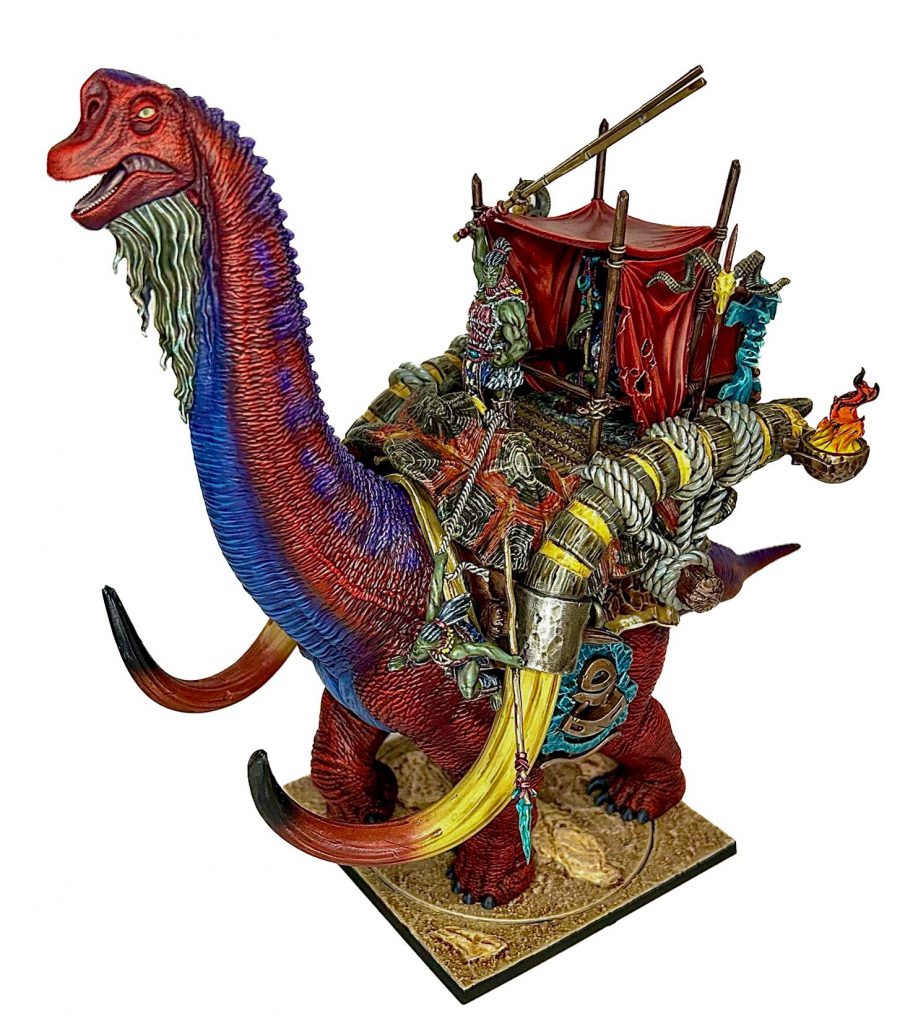
W’adrhŭn – B-
Speaking of buckets of stats, W’adrhŭn received one of the most divisive assessments by our cunning analysts, with almost half putting them in B tier (fine and good) and just over half in C (a bit below average, pls buff). We originally started writing this article before the July W’adrhŭn balance changes, and since then Sockbert has made the executive decision to bump them up to B after a couple of weeks testing. Yay democracy!
We don’t think it’s a particularly controversial statement that W’adrhŭn were hit hard in the February patch. In one fell swoop W’adrhŭn lost a plethora of tools, including Mantle of the Devoted, a range of abilities for the Tontorr Chieftain, and changes to the Shock warlord traits. While at least one of these (Sockbert’s beloved Mantle Tontorr) was absolutely necessary to break a negative joy play pattern, it did punch W’adrhŭn down hard from the hypothetical S tier they were at before. While the July tweaks have certainly bumped them up (in particular encouraging the use of cavalry), we don’t believe they’ve changed too much since; if anything, the update added only versatility rather than strength. Which is still a good thing!
It’s easy to stay anchored to the W’adrhŭn of yesteryear and evaluate them as they are now in comparison to where they were in January, when they had the most power per square inch delivered at the highest velocity of any faction in the game. W’adrhŭn still benefit from a great mix of units, strong ranged presence, powerful heavies and good-quality mediums with the ability to concentrate force anywhere on the table thanks to their chants – but they’re struggling to make it all work at the same time in a single list. We can imagine a W’adrhun list that’s truly terrifying, combining all these elements together to full effect. And that list is two and a half thousand points.
General Cross: The W’adrhŭn are a faction both defined by and shackled by the current Chant mechanics. The changes a year ago to allow more ready access to Conquest chants, including letting the big monsters chant, was a really cool benefit that helped the faction maintain tempo. This had unintended consequences with Fanatic units like Tontorrs and Thunder Riders that pushed the mechanic beyond where it should have really been. Para Bellum rightfully reigned this in at the start of the year.
The problem is striking the balance of costing and statting units. Given most units could receive up to three of 12 different buffs depending on the situation, you have a huge range of potential outcomes to balance. At the moment we’re on the cautious end of the faction’s balance, and I hope that the anticipated rework of the Chant system frees up PB to more closely balance the faction.
Sam Isaacson: Playing against an elite W’adrhŭn player isn’t a pleasant experience. With the right card timings it can feel like every unit is overpowered, but this faction faces two challenges. Firstly, most players aren’t elite, meaning every unit feels mediocre without lucky rolling. On the odd occasion the Chants really do their work it’s extremely rewarding but getting that to happen consistently is far too challenging at the moment. Secondly, the real threats in the army have obvious counters. Once you’ve been charged in the side by a Tontorr you simply don’t let that happen again, and once you’ve tasted the delicious effect of breaking a unit of Thunder Riders on their own turn through Lethal Demise the biggest advantages have been taken away. That all said, orcs riding dinosaurs remains an unreasonably pretty bunch of models to be pushing around a table.

Hundred Kingdoms – B-
Just barely scraping out of C tier, the Hundred Kingdoms’ position was also pretty divisive between B and C. Our longest-running Hundred Kingdoms player (Thanqol) describes them as “a collection of patches and band-aids masquerading as a coherent army,” considering the Hundred Kingdoms rely heavily on gimmicks to stay viable and being the army most likely to be undone by unfavorable terrain. As you can see below, though, the broader consensus is pretty favourable, with the faction offering a lot to explore and many alternate paths to take if one approach isn’t succeeding.
General Cross: The jack of all trades, Hundred Kingdoms can do everything to a decent standard. The skill to this faction should be a balanced army composition which takes advantage of whatever the opponents weaknesses are. It will be interesting to see where the faction goes next should the “Oops all horses” lists we’ve been seeing get toned back, hopefully alongside some buffs to their infantry.
Sam Isaacson: The Hundred Kingdoms remains the game’s ultimate Swiss army knife, with a bit of everything (except a Monster, but we don’t talk about that). Decent ranged. Decent magic. Decent resilience. Decent speed. No unit is bad, and no unit is standout. Even the Ashen Dawn really only perform with multiple units, and that comes with a big cost that might get stuck somewhere you don’t want it. For first-time players it’s the perfect faction. Highly intuitive and forgiving. But against any level of reasonable competitiveness a win rate of 0.5 feels pretty predictable because its strength is its weakness. Its ability to have an answer to every question means 100K lists tend to not be able to have the best answer to the more unique question it’s faced with.
Rob: I was one of the people who rated Hundred Kingdoms on the higher side, and I stand by that. They’re a faction that just works. Every unit does what it says on the tin, they have multiple viable army compositions despite the tide of cowcatcher-helmeted destriers at Adepticon, and it’s very easy to build lists for them that function intuitively but are also capable of surprising opponents. They can play wide, they can play tall, they can play elite elements supported by chaff, and it’s all solid. If they have a weakness, it’s that being well-rounded often means you lack an edge, which means that those factions in the upper brackets can feel just a tiny bit tougher than the on-paper discrepancy suggests.

City States – B+
City States have always been an interesting faction. They won Adepticon 2023 straight after release, but Ben Rislove is a player on par with Chuck Elswick and Ben’s combination of ability to read and counter the meta was the decisive element in that equation. Still, Para Bellum responded with some adjustments that broke up or toned down the most obvious ways to play the faction at release. City States sat at the lower end of the power curve for a long while after that, wondering whether Clockwork Hoplites would ever actually be released and whether they’d change much if they did. Only in 2024 has an entirely unexpected light emerged at the end of the tunnel, with a combination of incremental changes have really lifted the faction up over time, and the showcase and release of the new Talos and chariot models.
This ranking, it must be said, is made somewhat optimistically on the basis of the arrival of those new units, with the chariot especially representing a missing jigsaw puzzle piece slotting very neatly into the faction and pushing them out of B- all by itself. Early games played against these pieces by some members of the Goonhammer team are very promising, both on the merits of Chariots in a vacuum but also how they work in combination with many other units in faction.
General Cross: Much like Nords, the expectation of City States often doesn’t match the player experience. The army looks like slow, disciplined anvil phalanxes that work in cohesion with their hammers (Thyreans, Hephaestus) in a combined arms manner. In reality the Phalanxes are pretty fragile, the hammers can be unreliable and the army is oddly fast. As I mentioned in the Scoring Zones article, City States are really good at quick scenario plays.
All that being said, City States has some very powerful units with solid combinations in some places. With the Chariots and Talos arriving, I could see them rising to A tier in the near future.
Thanqol: Playing against City States is a very relaxing experience. They need to spend turn after turn powering up, putting things into the strategic stack, issuing battlefield orders, etc. While they’re doing that I’m running amok, getting stuff done and killing units. Regardless of their stats and occasional mobility tricks they play with no initiative, which I think makes them more feels-bad than their mechanics would suggest – nobody likes to sit it out and get beaten up for half a round.
Rob: I cannot emphasise enough how much of a difference there is between pre- and post-chariot City States. Ignore the lists people are throwing up online with ten chariots – you only need a few to see a difference, and that difference is pressure. While I’m nowhere near as down on City States’ ability to anvil as General Cross, I do consider the value of an anvil to be entirely contingent on your ability to force your opponent into it, and ranged pressure is one of your biggest tools in the toolbox to force engagement. Chariots even have a useful synergy with regiments like Selenoi or Thorakites, as they’re one of the best pieces in the game to capitalise on an aggressive reinforcement line.
Sam Isaacson: At the moment, City States feel like quite a wildcard faction. An opponent placing a Talos on the table has the same psychological impact as the Tontorr did when it first arrived for the W’adhrun; it’s tough to beat primarily because people haven’t had the experience to know how more than its impressive stat line. The same could be said of the Chariots, although when used well they really do add some needed maneuverability to the army, which makes them pretty intimidating to face now. They’re not slow but they feel it, which tempts their opponents to make assumptions and therefore mistakes.
Sockbert: Having now faced chariots for the first time just before we wrote this article, ohmigodtheyresogood.
A Tier
Aww yiss, the best of the best (kind of). Three armies dwell here and above, and let’s just say the discussions about them were clamourous. It’s well worth noting that an army can be in A-tier without representing a balance problem. Things are allowed to be powerful! The best A-tier armies are engaging, and dynamic, and powerful, but not in a way that feels like there no weaknesses to exploit. Even against an A-tier faction, you should feel like you had an out to win the game, if you’d maybe played a little better, or been a little luckier, or maybe taken an extra risk.
The worst A-tier armies are… well, we’ll get to that.
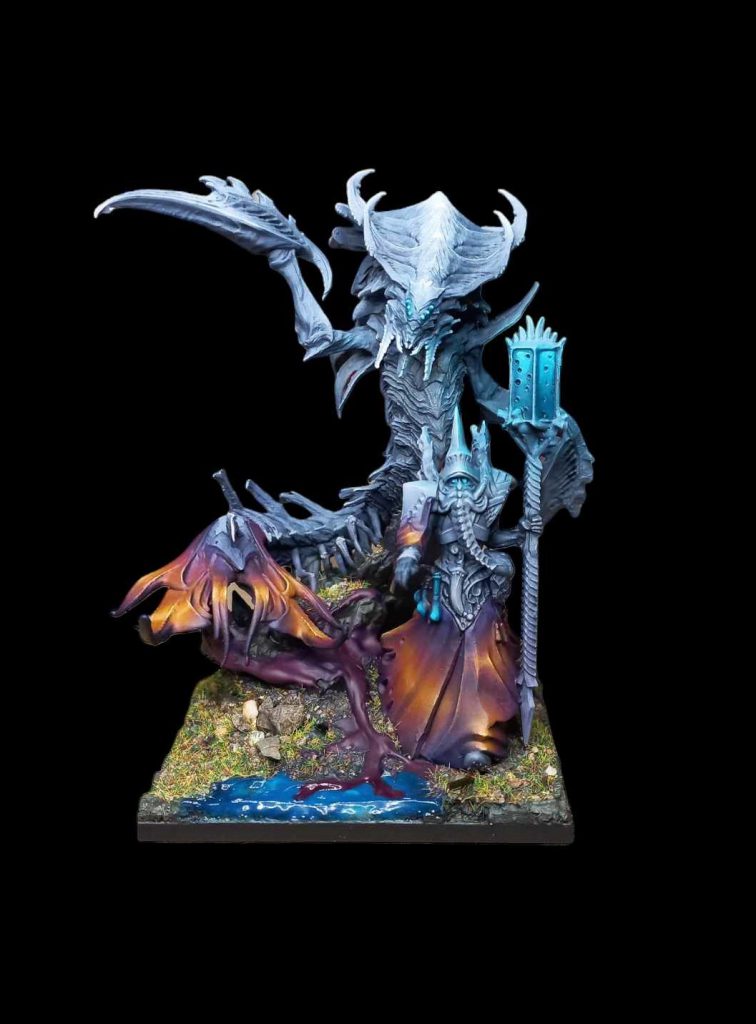
The Spires – A
A bit like Hundred Kingdoms, Spires are an army that contain multitudes, with a lot of variation not just across individual regiments but also across entire army archetypes. Unlike Hundred Kingdoms, spires list scale up and down hugely in terms of complexity. This means their baseline of performance is consistently solid (off the back of strong, low-complexity, well-rounded Superior Creations lists) but also gives them a tremendous ceiling when you put their highest-complexity Underspires and Directorate lists in the hands of a player who knows how to pilot them. Spires aggressively test the upper bounds for how much you can safely reward skill expression in a game and in the hands of the strongest players they perform like they’re overdue for a nerf, but even at their most basic they’re a pleasing mix of speed, durability and aggression.
Sockbert: The downside of results being so intimately tied to player skill in a way other factions aren’t is you’re sometimes left in a bit of a rut where if you’re learning the game, you’re not going to do great relative to if you’d started with another army, and if you run into an excellent Spires player you’re just going to have a bad time. There isn’t another army with a result spread, particularly among the higher-tiered factions; this is another force without a safety net, but also without the same kind of result ceiling. You just never know what kind of game you’re going to have encountering a new Spires player for the first time.
General Cross: Spires are an incredible faction. They have excellent and impactful support characters and an array of fast and effective units with the ability to surge buffs to wherever you need them. When you watch that Biomancer resolve a Draw Event, conduct two actions and resolve two Biomancies, usually drawing cards like he’s got Pot of Greed in his stack you can’t help but be overwhelmed. And then he activated into the Aura of Death (20) dronewall, just in case you thought he was sorry.
I’d like to see Spires have some of the more egregious outliers toned down a bit. The ability to activate four buffed Regiments in a row seems over the top, as do some of the stacked bonuses on things like Marksmen Clones. Unlike other factions, they could lose some of these capabilities and still compete comfortably without any corresponding buffs.
Sam Isaacson: The amount of tactical planning and short-term memory required for some of the Spires’ most impressive shenanigans is going to be a challenge for a lot of players, but when it works they can compete at the highest level. Synergistic lists provide huge bang for buck, with some of the cheapest units in the game doing the most work given the right conditions. When you see a Biomancer sending a 90-point, 3-stand unit almost 20 inches across the table and then getting it to score an objective there’s no wonder you feel it’s overpowered, until it tries to do anything in its own right. The ability to create enormous tarpits of force-grown drones behind a Pheromancer is hard for most armies to deal with, Biomancer upgrades turn decent units into great ones, and Superior Creations opens up elite options that feel as threatening as pretty much any other faction.
Rob: There are a lot of factors that are important in understanding why the best Spires players are so consistently high-performing with them, a lot of it boils down to the presence of biomancies and pheromancies as the Spires equivalent of a magic system. Pheromancies in particular and the associated abilities of the various ‘mancers replace needing to roll dice to succeed a spell with being able to automatically succeed if you just line your deck/positioning/game state up just right. Regardless, the faction is one of my easy favorites due to a mix of great special rules, varied army composition, and incredible internal synergies. At this point, the only buff I could reasonably ask for the faction is to relax the modelling and conversion rules so I can go as wild as I want with the aesthetic and still be able to play them in events. Oh, and maybe fix desolation drones, the poor things.

Dweghom – A
Dweghom are just solid as an army, reflecting their doughy dwarven history. There’s very little here that’s not at the very least entirely fine (Rob: except for the Bergont Raegh), and the rest ranges from “real good” to “real good”, with playstyles to match. Gunlines behind unbreakable fire-haired nutters? Done deal. Three or four rampaging monsters backed up by rank and file? Of course. Replacing that rank and file with some of the most elite infantry in the game with some of the best defensive and/or offensive stats around? You know they’re here too. Although the community remains firmly settled on the Tempered Creed as being the most effective way to play the faction, even within that limitation there remains a serious ability to flex into different, powerful options that shake up how the army plays. It’s not surprise that Dweghom was our only universally agreed upon tier, after Bair ruined our Spires vote by being one off from consensus.
General Cross: Dweghom have settled more comfortably into the meta than the last year with their outliers like Tempered Sorcerers and Steelforged getting brought back in line. Whilst they don’t have any units that feel way over the top now though the Elemental Potency tokens is what pushes them high. A naturally durable army that can generate auto-passes on dice rolls mitigates the biggest effect in an event: luck.
Sam Isaacson: Dweghom are an extremely strong faction. But they do risk feeling a bit one-dimensional. The “castle” strategy of protecting ranged units behind virtually unkillable front line means they can outlast pretty much any opponent across two-thirds of a table. With some factions that would make them straightforward enough to face, because it only needs one successful strategy to work, but the castle really does work. As those Elemental Potency tokens stack up their damage output matches their resilience. And need I point out the epic-ness of stone mechs?
Sockbert: There’s… very little to say about Dweghom in this context, really. They’re just good, and are by far the most workmanlike faction in Conquest. Nothing is weird or janky, they just have whatever you need to fill whatever roll you want and because of the simplicity baked into their core ruleset, you’ve got an incredible safety net waiting for you.
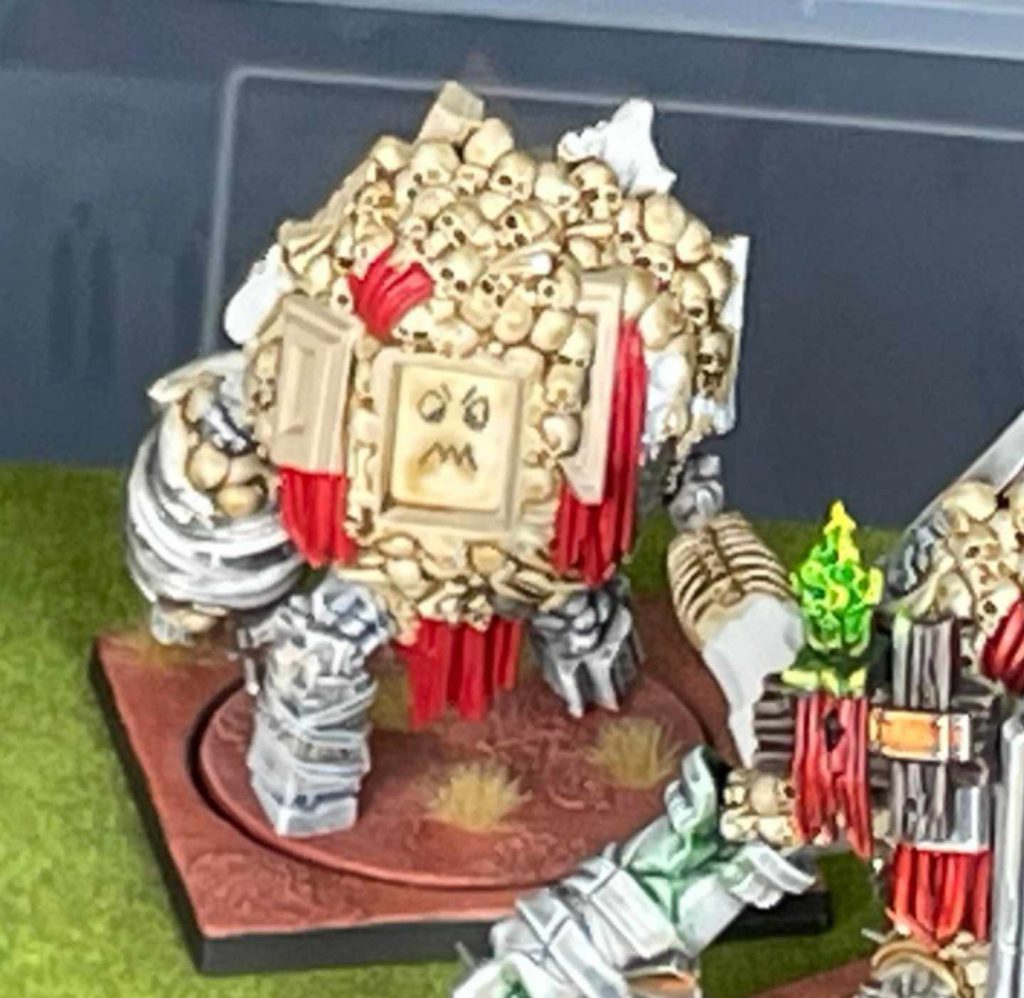
S-Tier
The Old Dominion – S
“Take 20 Aura of Death hits.” “My army doesn’t take resolve, your flank charge is meaningless and you’re stuck here.” “Oh, my reinforcement rolls are all one easier than yours.” “Um, you rolled four sixes to save, take twenty wounds.” These words and more are the bane of those of us who play into the current Conquest behemoth, the Old Dominion. While Old Dominion aren’t at the same level as a faction like Eldar at the height of their competitive power (the balance curve for Conquest has always been pretty damn tight), they’re still an overperformer and the only faction in this tier list that the team doesn’t just want but firmly expects to see nerfs over the next few balance patches.
General Cross: The glow up Old Dominion received in January 2024 is like a solar flare. The ultimate late-game faction gained some of the best opening plays in game, alongside points drops and an improved faction economy. The real reason why Old Dominion get to S tier for me though is because of how many base rules they ignore.
It’s a bit of a meme in our local group, but I firmly believe Old Dominion need to take Resolve damage. As well as a roughly 50% durability increase, they are functionally immune to Flanking, being Broken and declining Duels. It’s a huge range of core rules to ignore being you add on Resolve specific abilities such as Terrifying etc.
There’s also some oppressive combinations that could do with a review. Praetorian Guard are already one of the best anvils in game who apply a massive of Aura of Death. The Strategos really doesn’t need to be able to bring them on Turn 1 as well. Similarly, Insanity is a swingy spell that manages to hit well above its weight class by using the lowest modified Resolve. And that’s before the 6s become 4 hits! There are more things like the universal +1 to Reserve rolls that just don’t need to be there too.
Come on PB, time to make the Old Dominion play the same game as everyone else is.
Sam Isaacson: Old Dominion are horrible to play against. Almost everything that works against other armies simply underperforms against them because of their lack of Resolve. And their little bag of tricks that heals units back, prevents inspiring and everything else means they are a unique challenge to face. In some ways they’re the ultimate late game army, and if your Fallen Divinity starts taking hits too early you’re going to struggle, but the access to Vanguard and accelerated reinforcements makes them a horrible early game threat that means there’s no surprise they’re doing so well on the competitive scene.
Rob: While I personally ranked Old Dominion as an A+ rather than an S as they can struggle into the two factions we’ve rated A, Old Dominion are nevertheless a faction that have proven consistently difficult to balance for both casual and competition play. When they’ve been balanced (even a little strong) in casual play, they get resoundingly stomped in competition play by players who know how to exploit the weaknesses that are baked into the faction alongside their strengths. When they’re balanced for competition play, newer or more casual players play into them thinking they’re slightly shambly Hundred Kingdoms and end up breaking their wrists trying to punch out god. And right now, after multiple dials got turned in their favour in the last balance updates, they’re one of the best competition factions in the game, with only extremely practiced Spires and Dweghom (and maybe some City States) players able to put together a game plan that has a consistent shot at success. I’ll let you draw your own conclusions as to what effect that’s had on casual play.
We know there are changes on the way for Old Dominion, including the Brittle rule which will add some facsimile of the effect that resolve damage has on mortal armies. The challenge for Para Bellum will be to make sure the needle doesn’t swing too far back the other way.
Sockbert: Game balance should be secondary to player enjoyment. Right now, Old Dominion fail at both.
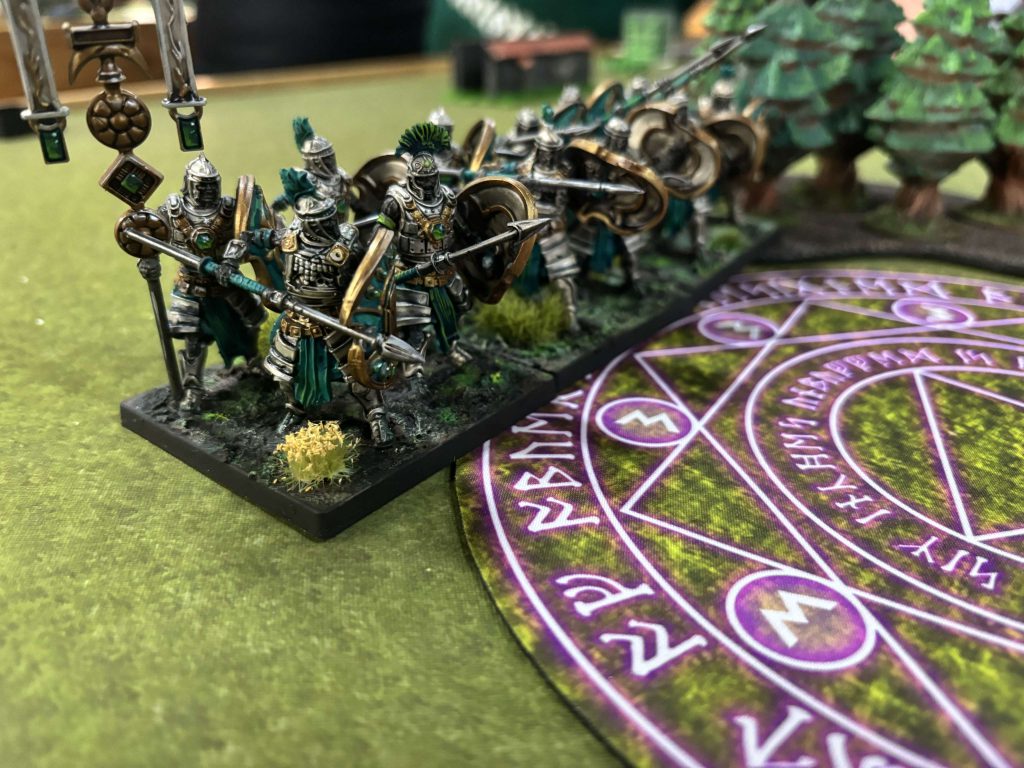
Wrapping Up and Heading Out
So what does this mean overall? Well, both everything and nothing. On the one hand, we’d love it if Para Bellum leaned in a bit more on at least hitting things that the community are just… not enjoying (like their emergency Ashen Dawn patch), but also that a good general can still do well with every one of these factions. It’s also very notable that there’s nothing at all we felt belonged in D-tier, and even those factions in C-tier are there due to factors that are pretty likely to be addressed in coming updates, based on Word of God from the Developers. Meanwhile, there’s only a single faction at the top of the pile that seems to seriously need to be dialed back, and even the Old Dominion don’t auto-win against the other A-tier factions. That’s very close to an excellent bill of health, especially on the assumption that there’ll be a balance update before the World Championship event in Chios in September.
Ultimately, chasing the dragon’s tail of the meta is a fool’s errand even in huge, slower moving games like 40k, let alone something with as many annual tweaks as Conquest. At the end of the day, collect what you want to paint and play with. This whole game? This whole hobby that we love? It’s about joy. Remember that.
And that W’adrhŭn are still the coolest army.

Have any questions or feedback? Drop us a note in the comments below or email us at contact@goonhammer.com. Want articles like this linked in your inbox every Monday morning? Sign up for our newsletter. And don’t forget that you can support us on Patreon for backer rewards like early video content, Administratum access, an ad-free experience on our website and more.
